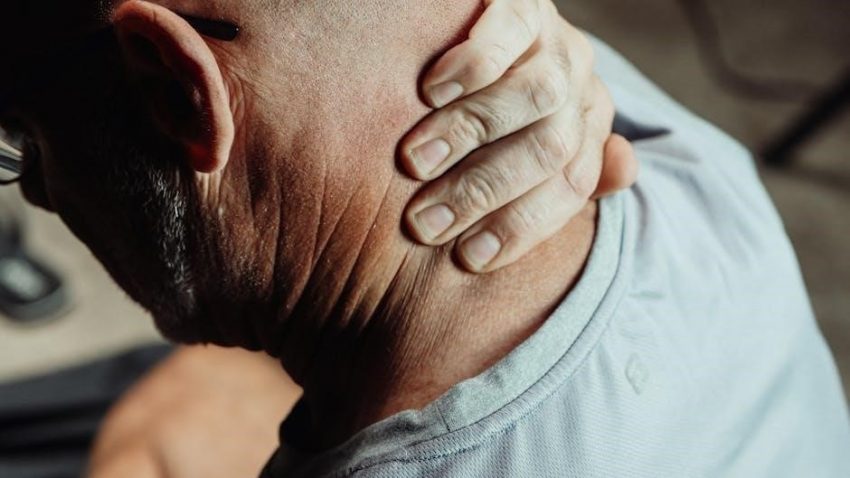Spinal stenosis is a condition where the spinal canal narrows, compressing nerves and causing pain․ Physical therapy plays a crucial role in managing symptoms through targeted exercises, core strengthening, and improving mobility, helping patients maintain an active lifestyle․
1․1 Overview of Spinal Stenosis
Spinal stenosis is a condition characterized by the narrowing of the spinal canal, which can compress the spinal cord and surrounding nerves․ It often results from age-related degeneration, such as osteoarthritis, and typically affects the lumbar or cervical regions․ This narrowing can lead to pain, numbness, or tingling, especially in the lower back or legs․ While it can be asymptomatic, severe cases may require medical intervention to relieve pressure and restore function․ Understanding its progression is key to effective management and treatment․
1․2 Role of Physical Therapy in Managing Spinal Stenosis
Physical therapy is a cornerstone in managing spinal stenosis, focusing on reducing pain, improving mobility, and enhancing quality of life․ Through tailored exercises, it strengthens core muscles, improves posture, and increases flexibility․ Therapists design programs to address individual needs, often incorporating stretching, strengthening, and aerobic activities․ These interventions aim to alleviate symptoms, delay progression, and help patients avoid surgery․ Regular physical therapy can significantly improve functional abilities and overall well-being for those with spinal stenosis․
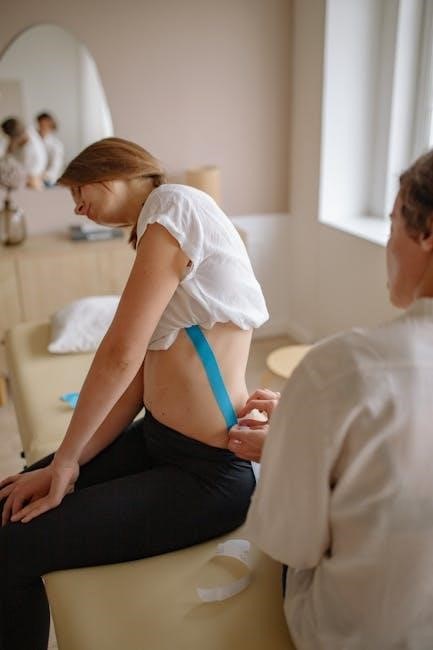
Understanding the Anatomy and Physiology of the Spine
The spine, composed of 33 vertebrae, discs, and ligaments, provides structural support, flexibility, and protection for the spinal cord․ Its anatomy ensures optimal nerve function and movement․
2․1 Structure of the Spine and Its Functions
The spine consists of 33 vertebrae, discs, and ligaments, forming a flexible yet resilient structure․ It supports the body’s weight, facilitates movement, and protects the spinal cord․ The vertebrae are categorized into cervical, thoracic, lumbar, sacrum, and coccyx regions, each serving specific functions․ The cervical spine allows neck mobility, while the lumbar spine supports heavy lifting․ Intervertebral discs act as shock absorbers, maintaining spinal flexibility and cushioning․ This intricate structure ensures posture, balance, and nerve protection, essential for overall bodily functions․
2․2 How Spinal Stenosis Affects the Spinal Cord and Nerves
Spinal stenosis narrows the spinal canal, compressing the spinal cord and surrounding nerves․ This compression disrupts nerve communication, leading to pain, numbness, and tingling․ Lumbar and cervical regions are most affected, causing symptoms like sciatica or neck pain․ Prolonged compression can impair motor function and reflexes, worsening quality of life․ Understanding this impact highlights the urgency of addressing spinal stenosis through targeted therapies to alleviate nerve pressure and restore function․
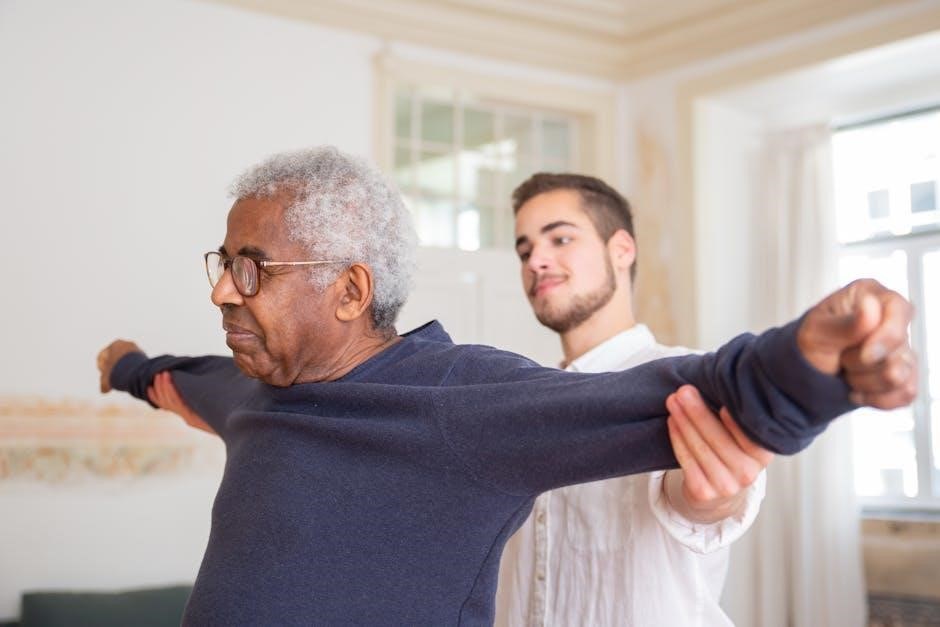
Symptoms and Diagnosis of Spinal Stenosis
Common symptoms include back or neck pain, numbness, tingling, and weakness․ Diagnosis involves physical exams, MRI scans, and X-rays to confirm spinal canal narrowing and nerve compression․
3․1 Common Symptoms of Spinal Stenosis
Common symptoms include lower back or neck pain, numbness, tingling, and weakness in the arms or legs․ Some patients experience difficulty walking or standing for long periods․ Pain often worsens with activity and improves with rest․ In severe cases, loss of balance or bladder control may occur․ Symptoms vary depending on the location and severity of the stenosis, with lumbar and cervical regions being most commonly affected․
3․2 Diagnostic Tests for Spinal Stenosis
Diagnosis typically involves a combination of clinical evaluation, imaging, and physical assessments․ Common tests include MRI and CT scans to visualize spinal narrowing․ X-rays may show bony changes, while electromyography (EMG) can assess nerve function․ A physical exam may reveal limited mobility or neurological deficits․ These tests help confirm stenosis and rule out other conditions, guiding appropriate treatment plans tailored to each patient’s specific needs and symptoms․
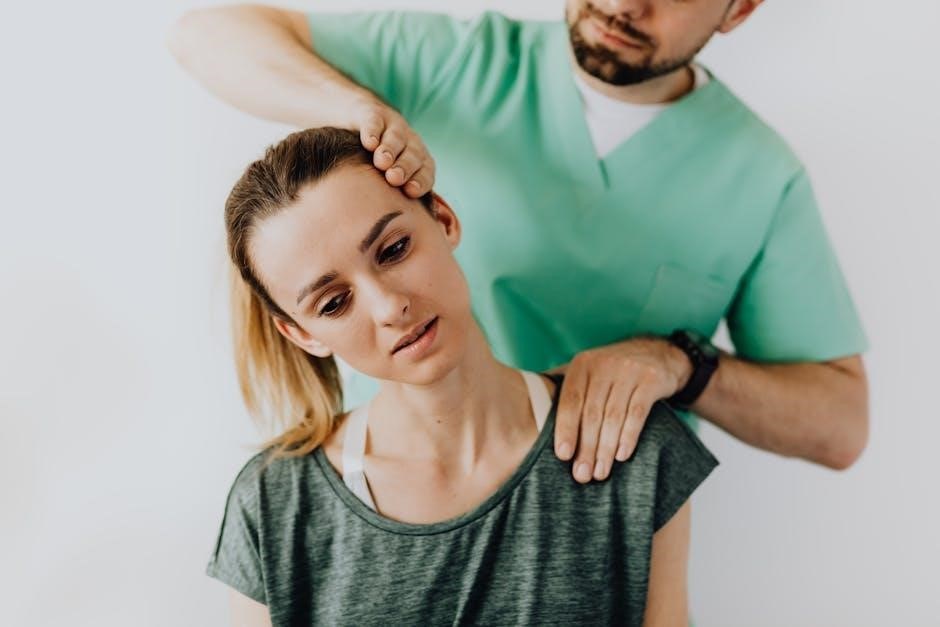
Benefits of Physical Therapy for Spinal Stenosis
Physical therapy improves mobility, reduces pain, strengthens core muscles, and enhances posture, offering a non-invasive approach to manage symptoms and promote overall well-being for patients․
4․1 Improving Mobility and Reducing Pain
Physical therapy for spinal stenosis focuses on improving mobility by targeting stiff joints and muscles․ Gentle exercises like pelvic tilts and cat-cow stretches enhance spinal flexibility, reducing stiffness․ These movements help alleviate pain by relieving pressure on compressed nerves․ Strengthening exercises improve posture, reducing strain on the spine․ Activities such as treadmill walking promote cardiovascular health without exacerbating symptoms․ By addressing both mobility and pain, physical therapy provides a comprehensive approach to managing spinal stenosis, helping patients maintain independence and improve their quality of life effectively․
4․2 Strengthening Core and Postural Muscles
Strengthening core and postural muscles is essential for spinal stability and pain reduction․ Exercises like bird-dog and pelvic tilts target abdominal and back muscles, improving posture and reducing strain on the spine․ Stronger core muscles help maintain proper spinal alignment, minimizing nerve compression․ Physical therapy programs often include exercises that enhance endurance and control, enabling patients to perform daily activities with greater ease and confidence, while preventing further progression of spinal stenosis symptoms effectively․
4․3 Enhancing Flexibility and Range of Motion
Improving flexibility and range of motion is vital for managing spinal stenosis․ Gentle stretching exercises, such as cat-cow stretches and thoracic spine stretches, help reduce stiffness and improve spinal mobility․ These exercises target tight muscles in the back, hips, and legs, alleviating nerve compression and enhancing movement․ Regular stretching also promotes better posture and reduces discomfort, allowing patients to perform daily activities with greater ease and confidence while supporting long-term spinal health and functionality․
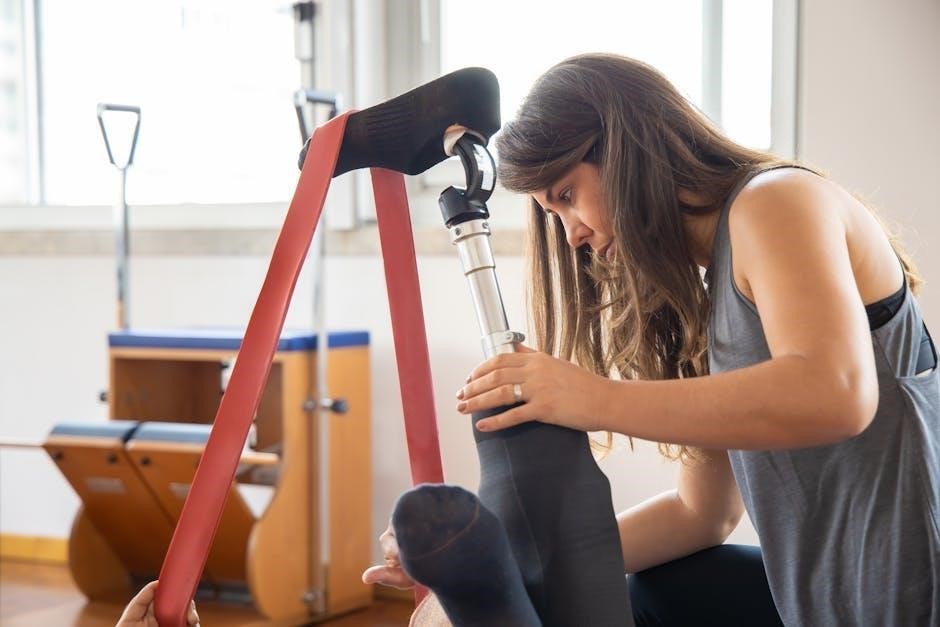
Key Exercises for Spinal Stenosis
Key exercises include pelvic tilts, cat-cow stretches, bird-dog, knee-to-chest stretches, and thoracic spine stretches․ These exercises improve mobility, reduce pain, and enhance spinal stability and flexibility․
5․1 Pelvic Tilts for Lumbar Mobility
Pelvic tilts are a gentle exercise to improve lumbar mobility and relieve stiffness․ Lie on your back with knees bent, feet flat․ Gently tilt your pelvis upward, lifting the base of your spine toward the ceiling, then lower․ This movement helps restore spinal flexibility and reduces pressure on the nerves․ Perform 10-15 repetitions, focusing on slow, controlled motions to enhance lower back mobility and comfort․ Regular practice can improve posture and reduce spinal stenosis symptoms․
5․2 Cat-Cow Stretch for Spinal Flexibility
The Cat-Cow Stretch is a foundational exercise that enhances spinal flexibility and relieves stiffness․ Start on your hands and knees in a tabletop position․ Inhale as you arch your back, lifting your head and tailbone (Cow pose)․ Exhale as you round your spine, tucking your chin and pelvis (Cat pose)․ Repeat for 10-15 repetitions․ This exercise gently mobilizes the spine, improving range of motion and reducing tension in the lumbar region․ Regular practice can help alleviate spinal stenosis symptoms and improve posture․ Always perform slowly and within a pain-free range․
5․3 Bird-Dog Exercise for Core Stability
The Bird-Dog Exercise strengthens the core and improves balance and posture․ Start on your hands and knees․ Extend your right arm and left leg simultaneously, keeping them straight, while maintaining a neutral spine․ Hold for a few seconds, then return to the starting position․ Alternate sides for 10-15 repetitions․ This exercise enhances spinal stability, essential for managing spinal stenosis․ It also engages abdominal muscles, promoting proper spinal alignment and reducing strain on the lower back․ Perform slowly and avoid arching your back during the movement․
5․4 Knee to Chest Stretch for Lower Back Relief
The Knee to Chest Stretch targets the lower back and hip flexors, providing relief from spinal stenosis symptoms․ Lie on your back with knees bent and feet flat․ Bring one knee toward your chest, holding onto it with your hand․ Gently pull until a stretch is felt in the lower back and buttocks․ Hold for 20-30 seconds, then return to the starting position․ Repeat on the other side․ This stretch helps reduce tension in the lumbar region and improves flexibility, making it easier to perform daily activities without discomfort․ Perform this stretch 2-3 times on each side for optimal relief․
5․5 Thoracic Spine Stretch for Upper Back Mobility
The Thoracic Spine Stretch enhances upper back flexibility and reduces stiffness․ Sit or stand with good posture, clasp your hands behind your back, and gently pull your shoulders backward․ Alternatively, use a towel or strap across your chest for assistance․ Hold for 20-30 seconds, breathing deeply․ This stretch improves thoracic spine mobility, alleviating tension and promoting better posture․ Repeat 3-4 times, ensuring smooth, controlled movements․ Perform this stretch twice daily to maintain upper back health and reduce spinal stenosis-related discomfort․
5․6 Gentle Aerobic Exercises for Overall Health
Gentle aerobic exercises, such as treadmill walking or swimming, are excellent for improving cardiovascular health without straining the spine․ These low-impact activities promote blood flow, strengthen muscles, and enhance endurance․ They can be adapted to individual fitness levels, making them suitable for those with spinal stenosis․ Regular aerobic exercise helps maintain a healthy weight, reducing pressure on the spine․ Incorporate these exercises 2-3 times a week for 20-30 minutes to support overall well-being and spinal health․ Always consult a physical therapist for personalized recommendations․
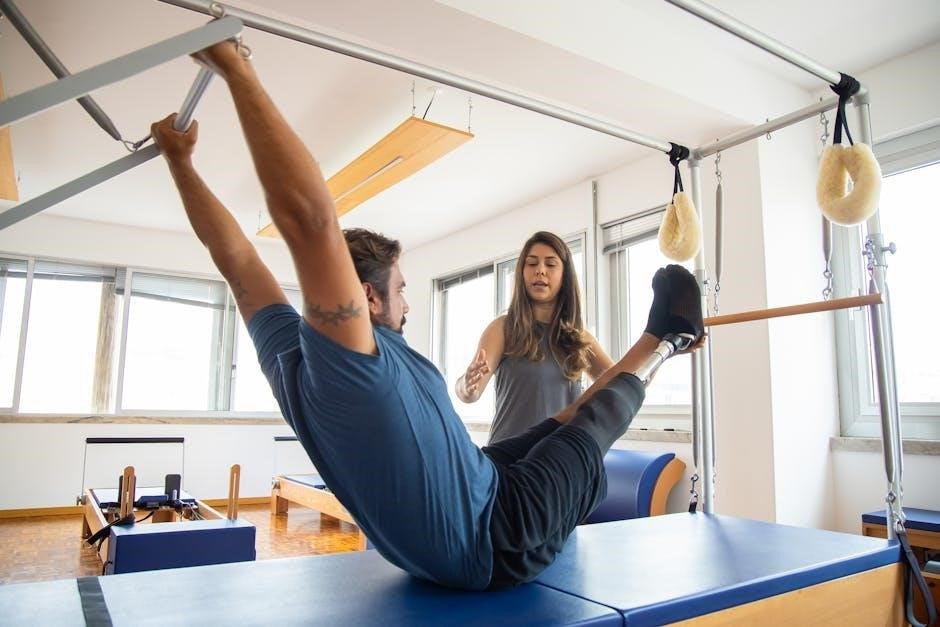
Creating a Home Exercise Program
A well-structured home exercise program for spinal stenosis includes stretching, strengthening, and aerobic exercises tailored to individual needs․ Ensure a safe and effective routine by consulting a physical therapist to monitor progress and adjust exercises as necessary․
6․1 Setting Up a Safe and Effective Routine
Setting up a safe and effective home exercise routine for spinal stenosis begins with a consultation with a physical therapist to design a personalized plan․ The routine should include a combination of stretching and strengthening exercises, along with gentle aerobic activities․ It’s important to start slowly, ensuring each exercise is performed correctly to avoid injury․ Monitoring progress and adjusting the routine as needed helps maintain effectiveness and safety․ Consistency is key to achieving long-term benefits and managing symptoms effectively․
6․2 Incorporating Stretching and Strengthening Exercises
Incorporating stretching and strengthening exercises into a home program for spinal stenosis can improve flexibility and reduce pain․ Stretching exercises, such as pelvic tilts and cat-cow stretches, help relieve tight muscles and improve spinal mobility․ Strengthening exercises, like bird-dog and core stabilizations, enhance muscle support for the spine․ These exercises should be done gently and within a pain-free range to avoid exacerbating symptoms․ Consistent practice helps maintain spinal health and prevents further degeneration, promoting overall well-being and functionality․
6․3 Monitoring Progress and Adjusting Exercises
Monitoring progress is essential to ensure exercises remain effective and safe․ Track improvements in symptoms, pain levels, and movement quality․ Regular assessments, such as weekly check-ins, help identify the need for adjustments․ If exercises become too easy or symptoms persist, modifications like increasing intensity or changing exercises are necessary․ Open communication with a physical therapist ensures the program evolves based on individual needs, promoting continued improvement and long-term spinal health․
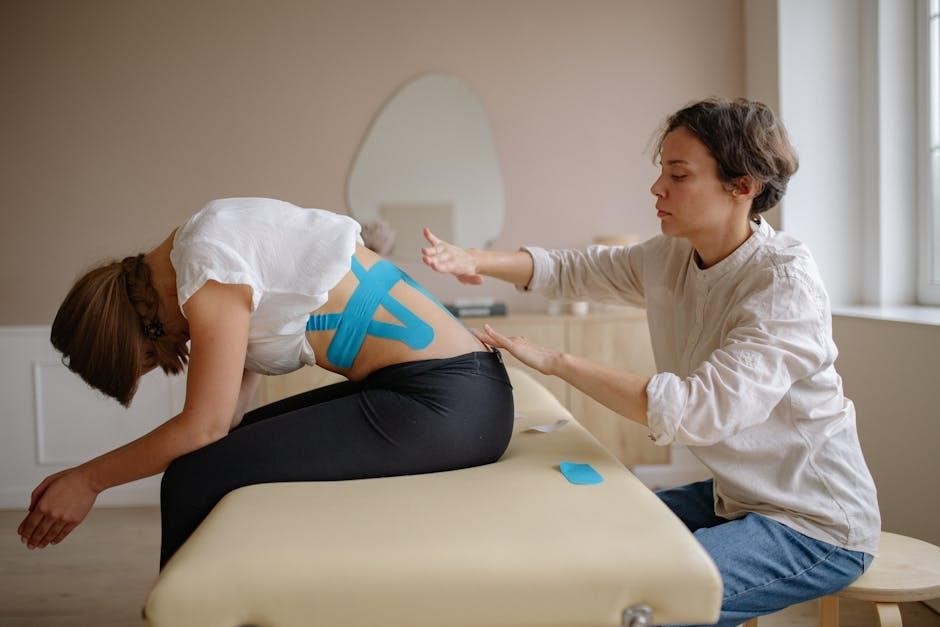
Lifestyle Modifications to Manage Spinal Stenosis
Maintaining proper posture, avoiding heavy lifting, and managing weight are crucial․ Using supportive chairs and mattresses can reduce strain․ These modifications complement physical therapy, enhancing overall well-being and mobility․
7․1 Maintaining Proper Posture
Maintaining proper posture is essential for managing spinal stenosis․ Sitting and standing with good alignment reduces strain on the spine, preventing further narrowing․ Using ergonomic chairs and supportive mattresses can help․ Avoid slouching or bending excessively, as this can worsen symptoms․ Regular posture checks and mindfulness during daily activities are key․ Strengthening core muscles through exercises like pelvic tilts and cat-cow stretches can also improve spinal alignment․ Good posture reduces pressure on nerves, alleviating pain and improving mobility․
7․2 Avoiding Activities That Worsen Symptoms
Certain activities can exacerbate spinal stenosis symptoms, such as heavy lifting, prolonged sitting, or high-impact exercises․ Avoid bending at the waist and instead bend at the knees to reduce spinal strain․ Minimize repetitive twisting or overhead reaching․ Taking regular breaks to stretch and move can help prevent stiffness․ Modifying daily tasks to avoid aggravating the condition is crucial for managing symptoms effectively and preventing progression․ Consulting a physical therapist can provide personalized guidance on activity modifications․
7․3 Importance of Weight Management
Maintaining a healthy weight is essential for managing spinal stenosis․ Excess weight increases pressure on the spine, worsening symptoms like pain and numbness․ Losing weight through a balanced diet and low-impact exercises can reduce spinal strain and improve mobility․ A healthy weight also enhances the effectiveness of physical therapy exercises, helping to alleviate symptoms and slow disease progression․ Consulting with a healthcare provider or physical therapist can provide tailored strategies for weight management and overall spinal health․

Advanced Physical Therapy Techniques
Manual therapy improves joint mobility, neural mobilization enhances nerve flexibility, and treadmill walking promotes gentle aerobic conditioning, all tailored to address spinal stenosis symptoms effectively․
8․1 Manual Therapy for Improved Intervertebral Motion
Manual therapy involves hands-on techniques to enhance spinal mobility and reduce stiffness․ Techniques like spinal mobilization and soft tissue massage target the affected areas, improving intervertebral motion and alleviating pressure on nerves․ This approach helps restore natural movement, reducing discomfort and enhancing overall spinal function․ By addressing specific joint restrictions, manual therapy can be a key component in managing spinal stenosis symptoms and improving patient outcomes․
8․2 Neural Mobilization Techniques
Neural mobilization focuses on improving the mobility of nerves and reducing tension within the nervous system․ These techniques target areas where nerves may be compressed due to spinal stenosis․ By gently moving the nerves and surrounding tissues, physical therapists can help restore normal nerve function, alleviate pain, and improve overall spinal mobility․ Regular neural mobilization can enhance symptom relief and support long-term management of spinal stenosis, making it a valuable component of a comprehensive physical therapy program․
8․4 Treadmill Walking for Gentle Aerobic Conditioning
Treadmill walking is a low-impact aerobic exercise ideal for individuals with spinal stenosis․ It promotes cardiovascular health, strengthens muscles, and improves mobility without excessive spinal stress․ Patients can adjust speed and incline to suit their comfort level, making it a versatile option․ Regular treadmill walking, combined with proper posture and breathing techniques, can enhance endurance while minimizing strain on the spine․ Always consult a physical therapist to tailor the routine to individual needs and ensure safe progression․
When to Consult a Physical Therapist
Consult a physical therapist if experiencing persistent pain, numbness, or mobility issues․ They provide personalized exercises and guidance to safely manage spinal stenosis symptoms․
9․1 Signs That Indicate the Need for Professional Guidance
Individuals should seek professional guidance if they experience persistent pain, numbness, or weakness in the legs or arms․ Difficulty walking or standing for long periods, or symptoms worsening over time, are key indicators․ Consulting a physical therapist is essential to develop a personalized exercise program and prevent further progression of spinal stenosis․
9․2 How a Physical Therapist Can Tailor Exercises to Individual Needs
A physical therapist assesses the patient’s specific condition, including pain levels, mobility, and strength․ They design personalized exercise plans focusing on core strengthening, flexibility, and gentle aerobic activities․ The therapist monitors progress, adjusting exercises to ensure safety and effectiveness․ This tailored approach addresses individual limitations and goals, maximizing benefits while minimizing risks, and helping patients achieve optimal spinal health and functionality․
Physical therapy effectively manages spinal stenosis, improving mobility and reducing pain․ Begin or continue a tailored program, focusing on exercises that enhance flexibility, strength, and overall spinal health․
10․1 Summary of Key Takeaways
Spinal stenosis can be effectively managed with physical therapy, focusing on exercises that improve flexibility, strength, and posture․ Regular routines, including core strengthening and gentle stretches, enhance mobility and reduce pain․ Monitoring progress and adjusting exercises ensure long-term benefits․ Combining these strategies with lifestyle modifications supports overall spinal health and improves quality of life for individuals with spinal stenosis․
10․2 Encouragement to Begin or Continue a Physical Therapy Program
Embracing a physical therapy program can significantly improve mobility, reduce pain, and enhance overall quality of life for those with spinal stenosis․ Consistency is key, as even small steps lead to progress․ A tailored approach by a physical therapist ensures safety and effectiveness․ Don’t hesitate to start or continue your journey—each session brings you closer to better spinal health and independence․ Take the first step today and commit to a healthier, pain-free tomorrow․

